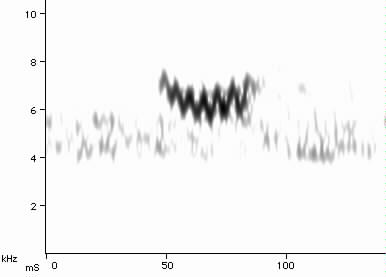
Hooded Warbler Wilsonia citrina
Flight call description A short, low, finely buzzy "dznt", typically with an upward arch.
Fig.1. New Jersey September 11, 1999 (MO).
Bird in flight.
Similar species See Kirtland's and Chestnut-sided Warblers. Similar also to Common Yellowthroat but higher and with a finer buzz. See buzz calls.
Behavior Primarily a nocturnal migrant but engages in redetermined migration. Seems to give flight call primarily while in active migration flight (either at night or in redetermined migration) and only rarely on the breeding grounds.
Spectrographic description Measured calls (N=2) were 42.3-42.9 (42.6) mS in duration and in the 5.9-7.3 (6.0-7.2) kHz frequency range. The frequency track was single-banded and upward-arched or level. Modulations showed a spacing of 5.7-6.1 (5.9) mS between humps and a depth of 600-1200 Hz. The depth of the modulations typically increased toward the end of the call. Presumed nocturnal flight calls measured (N=6) were 40.2-55.0 (47.6) mS in duration and in the 5.2-7.3 (5.5-7.0) frequency range. Calls were modulated with a spacing of 6.8-7.4 (7.1) mS between humps and a depth of 580-1200 Hz. In most cases, the depth of the modulations increased as the call progressed.
Discussion Our diurnal experience is limited to two recorded individuals and a few others heard, yet we have recorded many presumed Hooded Warbler flight calls in night migration.